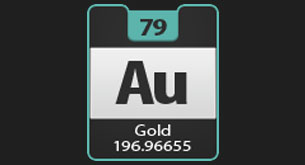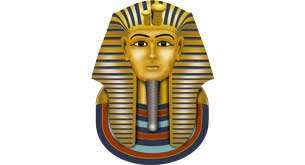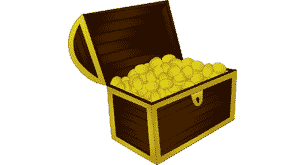
On the Periodic Table of elements gold has the symbol Au
Gold Facts
- Gold is an element on the Period Table. It has a chemical symbol of Au.
- Gold has an atomic number of 79 so it has 79 protons.
- Gold has an atomic mass of 197 (197-79 = 118) so it has 118 neutrons.
- Gold has a high unit weight. Gold's unit weight is 315.2 g/cu inch (19.3 g/cu cm). Gold is therefore about 19 times heavier than the same amount of water and 3 times heavier than iron. This property of gold makes it possible for people to find gold by "panning for gold". Gold prospectors place sand and gravel in a pan and wash and swirl water around so all the gold sinks to the bottom because it is heavier.
- Gold is considered a precious metal. Some countries base their currency by having gold reserves.
- 45 percent of the world's gold supply is locked in bank vaults in gold bars.
- Gold is mined on every continent except Antarctica. Scientists think there may be huge amounts of gold in Antarctica, but an international treaty bans miners from finding gold there.
- Prior to the 1800's most of the world's gold came from Ghana, which is in West Africa. Today this area of Africa is still called the Gold Coast.
- The 1800's brought many gold discoveries around the world. In 1848, a man named James Marshall found gold in California near the Sierra Nevada Mountains. This was the start of the California gold rush.
- In 1851 gold was discovered in Australia.
- In 1886 gold was discovered in South Africa, leading to the start of a war between the British and Boers (Dutch settlers).
- In 1896 gold was discovered in the Yukon, which is now Alaska (50th U.S. State).
- Today, the leading gold mine locations are South Africa, Russia, the United States, Canada, Australia, Brazil and China. The Transvaal Province of South Africa (near Johannesburg) produces over a quarter of the world's annual gold production.
- The world's largest gold nugget found was over 5 feet tall found in Hill End, Australia in 1872. It weighed 204 lbs (93kg).
- Gold is very soft. It is possible to cut gold with a knife. Gold is also the most ductile of all metals. It is possible to press gold into a foil with a thickness of less than 5 millionths of an inch (0.12 millionths of a meter). It is also possible to flatten one ounce (28.3 grams) of gold into a sheet 100 square feet (9.3 square meters) in size or a wire nearly 1 mile (1.6 km) long.
- At room temperature gold is a solid. Pure gold melts at 1943 degrees F (1062 degree C).
- Gold is measured in karats. A karat is a measure of the pure gold in a gold alloy. 24 karat gold is pure gold. 14 karat gold is 58.3 percent pure gold. 18 karat gold is 75 percent pur gold.
- The word carat, when used to describe gold is not the same as karat. Carat is a unit of weight, not a measure of the percent of pure gold.
- It is popular to mix copper with gold since copper significant lowers the melting point of gold, making is easier to form.
- Gold has the lowest oxidation potential of all the metals on the Periodic Table. This property is very important for batteries. In theory, using gold as the cathode of a battery would result in the most powerful battery possible.
- Gold is one of the best conductors of electricity of any metal.
- Gold is one of the best conductors of heat of any metal.
- Gold does not rust like iron and steel when exposed to water and air. Gold does not corrode like copper when exposed to the air.
- Compared to most metals, gold has atomic bonds that are very loose allowing the atoms to slide past each other.
- A gold film was applied to the Apollo 11 astronauts helmet visors when they landed on the moon. The gold reflects the suns visible light and most of the infrared radiation from the sun.
- Some people use gold to fill tooth cavities. Over 12 tons of gold is used to fill teeth each year in the United States alone!
- Scientists have successfully shown that liquid with specks of gold can destroy cancer cells in the prostate and ovaries.
- For a long time scientists have tried to convert other metals to gold. Ancient chemists who tried unsuccessfully to make gold from other metals are called alchemists.

Gold is very popular with jewelry. For many years gold was used to show royalty.

Coins were made of gold many years ago. With today's cost of gold, most coins are now made with cheaper metals such as nickel and copper.
